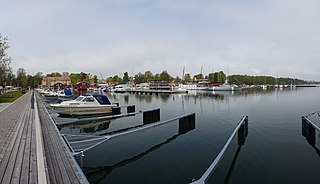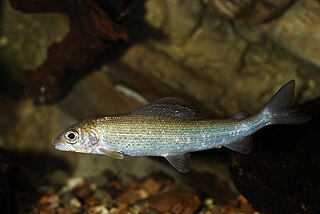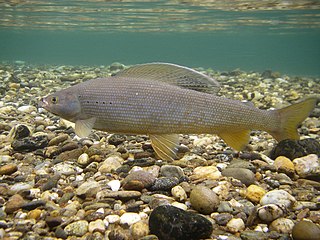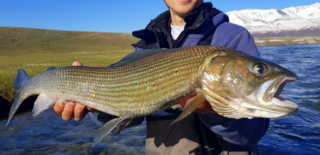
Lake Baikal is the deepest rift lake in the World. It is situated in southern Siberia, Russia between the federal subjects of Irkutsk Oblast to the northwest and the Republic of Buryatia to the southeast.

Hjo Municipality is a municipality in Västra Götaland County in western Sweden. Its seat is located in the city of Hjo.

Thymallus, commonly known as graylings, is a genus of freshwater ray-finned fish and the only genus within the subfamily Thymallinae of the family Salmonidae. Although all Thymallus species can be generically called graylings, without specific qualification the term "grayling" typically refers to the type species Thymallus thymallus, the European grayling.

Thymallus thymallus, the grayling or European grayling, is a species of freshwater fish in the salmon family Salmonidae. It is the only species of the genus Thymallus native to Europe, where it is widespread from the United Kingdom and France to the Ural Mountains in Russia, and Balkans on the south-east, but does not occur in the southern parts of the continent. It was introduced to Morocco in 1948, but it does not appear to have become established there.
Grayling or Greyling may refer to:

The Arctic grayling is a species of freshwater fish in the salmon family Salmonidae. T. arcticus is widespread throughout the Arctic and Pacific drainages in Canada, Alaska, and Siberia, as well as the upper Missouri River drainage in Montana. In the U.S. state of Arizona, an introduced population is found in the Lee Valley and other lakes in the White Mountains. They were also stocked at Toppings Lake by the Teton Range and in lakes in the high Uinta Mountains in Utah, as well as alpine lakes of the Boulder Mountains (Idaho) in central Idaho.

The Amur grayling is a species of freshwater ray-finned fish from the genus Thymallus (graylings) of the family Salmonidae, endemic to the Amur basin in Russian Far East and Northeast China and also the Onon and Kherlen basins in Mongolia. It is sometimes difficult to differentiate the species with the Lower Amur grayling. It is seen as a game fish and food fish in Russian Far East and the Chinese Heilongjiang province.
The East Siberian grayling(Thymallus pallasii) is a grayling in the salmon family Salmonidae. Males can reach a size of 44 cm (17 in).
Thymallus yaluensis, also known as Yalu grayling, is a putative species of freshwater ray-finned fish from the genus Thymallus (graylings) in the family Salmonidae. It is endemic to the upper Yalu River on the China-North Korea border.

Lake Khövsgöl is a lake in Khövsgöl Province, Mongolia. It is the largest freshwater lake in the country by volume and second largest by area after Uvs Lake. It is nicknamed the "Younger sister" of those two "sister lakes".

Grebe Lake is a 156 acres (0.63 km2) backcountry lake in Yellowstone National Park most noted for its population of Arctic grayling. Grebe Lake comprises the headwaters of the Gibbon River. Grebe Lake is located approximately 3.1 miles (5.0 km) north of the Norris-Canyon section of the Grand Loop Road. The trail to the lake passes through mostly level Lodgepole Pine forest and open meadows. The lake was named by J.P. Iddings, a geologist with the Arnold Hague geologic surveys. There are four backcountry campsites located on the lake.

The Montana Arctic grayling is a North American freshwater fish in the salmon family Salmonidae. The Montana Arctic grayling, native to the upper Missouri River basin in Montana and Wyoming, is a disjunct population or subspecies of the more widespread Arctic grayling. It occurs in fluvial and adfluvial, lacustrine forms. The Montana grayling is a species of special concern in Montana and had candidate status for listing under the national Endangered Species Act. It underwent a comprehensive status review by the U.S. Fish and Wildlife Service, which in 2014 decided not to list it as threatened or endangered. Current surviving native populations in the Big Hole River and Red Rock River drainages represent approximately four percent of the subspecies' historical range.

Thymallus baicalensis, also known as the Baikal black grayling, is a Siberian freshwater fish species in the salmon family Salmonidae.
Thymallus ligericus, the Loire grayling, is a European freshwater fish species in the salmon family Salmonidae. The species is endemic to the upper Loire drainage in France, where it lives in medium to large foothill, canyon and plateau rivers of the mountainous regions.

The Kamchatka grayling is a grayling in the salmon family Salmonidae. The fish grows up to 50 cm (20 in). It is found in freshwater habitats of the Russian Far East, including the Kamchatka Peninsula, eastern part of Magadan Oblast and northwards to the southern Chukchi Peninsula.

The Mongolian grayling is a freshwater species of fish of the genus Thymallus endemic to the landlocked rivers in Mongolia, Inner Mongolia Province of China and nearby parts of Russian far east. It is considered to be the largest grayling species in the world, and hence viewed as an auspicious sign by local tribes.

Thymallus svetovidovi, also known as the Upper Yenisei grayling, is a species of freshwater fish in the salmon family. It is found in the upper reaches of the Yenisei River and in western Mongolia.

Thymallus tugarinae, also known as the Lower Amur grayling, is a species of freshwater fish in the salmon family. It is found in the lower reaches of the Amur river on the border of the Russian far east and Heilongjiang Province of China. It was first described in 2007 and is sometimes mistaken for the Amur grayling.
Thymallus nigrescens, also known as the Hovsgol grayling, is a species of freshwater fish in the salmon family. It is endemic to the Mongolian Lake Khovsgol where they usually live near or on the bottom of the lake.













